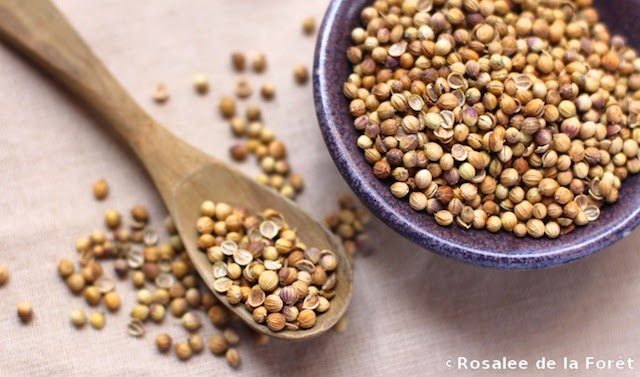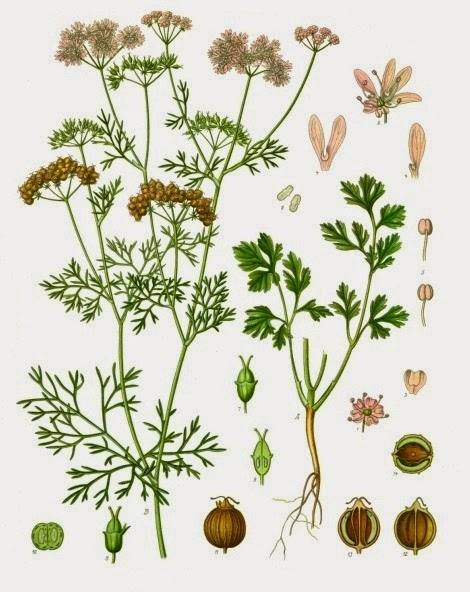Get weekly tips, recipes, and my Herbal Jumpstart e-course! Sign up for free today.

Coriander Benefits
Share this! |
|
Cilantro vs CorianderThe Coriandrum sativum plant produces two distinct kinds of culinary and medicinal herbs. The leaves are commonly referred to as cilantro. They are aromatic and cooling in nature and have a decidedly different taste than the seeds. |
The fruit of the Coriandrum sativum plant are referred to as coriander seeds. They have a pungent taste that is warming and drying. Coriander seeds are a medicinal plant and a common culinary spice.
This article focuses on coriander seeds.
History of Coriander
Coriander is reputably one of the oldest known medicinal spices and has been used for at least 7,000 years. The spice was found in the tomb of King Tutankhamen and the seeds were mentioned in the Bible.
Coriander seeds were a common ingredient in love potions in the Middle Ages and it was an official medicine in the U.S. Pharmacopoeia from 1820 until 1980.
During WWII coriander seeds were covered in sugar and sold as candy. They have also been used in a similar manner for kids with tummy aches.
Coriander has a long history of use for preserving meat and it was often combined with vinegar for these purposes. Corned beef is a popular example of coriander spiced meat.
Coriander seeds are used in distilling spirits, notably the French Chartreuse. It is also a common ingredient in Belgian beers.
People in the US eat more than 900,000 pounds of coriander a year, most of which is found in meats such as sausages and also pastries and sweets.
"It’s almost impossible to use too much coriander. (In North American cuisine, some recipes call for it by the cupful!) In fact, coriander can fix a lot of errors in cooking. If you’ve gone too heavy on a particular spice in a dish, add the same amount of ground coriander, which should correct the flavor. This works particularly well when you’ve overdone a strong spice such as clove or cinnamon." - Bharat Aggarwal, Healing Spices
Coriander Benefits
Coriander is a fairly straightforward herb but it does have a few surprising uses.
Coriander Benefits for Digestion
Coriander is best known as a carminative herb. It has a pungent taste that is warming and drying, which makes it a perfect match for damp and cold digestive problems.
Signs of damp and cold digestion include frequent bloating, belching, a heavy feeling in the abdomen, a cold feeling in the abdomen, loose stools with undigested food, a thick white tongue coating, scallops on the side of the tongue and fatigue.
Coriander
is an important corrigent herb. Corrigent herbs are added in small
amounts to formulas to help balance them. Sometimes they are used to
improve the flavor of a formula. Coriander is often added to bitter
formulas to improve the taste. It is often added to laxative formulas to
prevent the griping caused by herbs like senna and rhubarb.
Coriander Benefits the Regulation of Blood Sugar
Coriander
seeds have a mild effect on blood sugar levels and could be part of a
larger protocol to help regulate blood sugar levels.
Coriander Benefits for Heart Health
Coriander
seeds have numerous benefits for the heart. They have been shown to
lower blood pressure and optimize cholesterol levels, and they are strongly
antioxidant, which can support heart health.
Coriander Benefits Against Infections
Coriander is a mild antimicrobial herb. It’s been shown to be effective against fungal infections likecandida. It’s also both diuretic and antimicrobial, making it a great herb for urinary tract infections.
I’ve
seen many references to coriander being used for cold and flu symptoms.
Being a pungent spice we can surmise it would be beneficial for
wind/cold fevers and mucus congestion. I have not found any contemporary
references to herbalists regularly using coriander for colds and the
flu.
Coriander Benefits Against Cancer
Coriander has been studied for its ability to prevent cancer. Promising results have been shown for preventing colon cancer. Another interesting study showed the roots as having strong antioxidant activity that could “prevent oxidative stress-related diseases”.
Botanically Speaking
|
Native to the Mediterranean, coriander is now found growing wild as well as cultivated all over the world. Depending on the climate it can grow as an annual or as a biannual. It grows from 2 to 3 feet high. The aromatic leaves (called cilantro) are compound and made up of leaflets. They grow in an alternative pattern. The flowers grow in an umbel and have five petals and five stamens. The
fruits are round and a dull yellow or tan color. They measure about 2-6
mm. Coriander fruits are commonly referred to as the seeds. |
Uses of Coriander
The most common way to use coriander is as a culinary spice. It is frequently used in curry mixes and North African cuisines. For best results buy the whole seeds and then grind them up fresh. The whole seeds are often roasted before grinding. If you want to buy ground coriander buy it from a reputable source and only buy in small quantities. Ground coriander loses a lot of its flavor fairly quickly.
Besides culinary use there are several medicinal preparations for coriander seeds.
They can be used externally as a poultice or a compress for menstrual cramps, arthritic joints, and headaches.
Seeds can be ground into a paste and used on mouth and skin ulcers.
Coriander is frequently added to other formulas to help improve the taste or to prevent intestinal spasms (common with laxative formulas).
The seeds can be made into a tea. A cold infusion is recommended or a hot infusion that is covered immediately.
The recommended dosage of coriander is 2.5 - 5 grams.
Coriander roots are also edible and are used in Asian cuisine.
Special Considerations
Coriander seeds are considered safe for most people; however, a small number of people are severely allergic to coriander.
People who are on blood-regulating medication or using insulin should have their blood sugar levels monitored if they are regularly taking coriander, as it could lower their blood sugar levels.
Summary
Coriander is a common culinary spice that has been used by humans for thousands of years. Its main use is for stagnant and cold digestion and has long played an important role in balancing formulas. Besides being used to support healthy digestion, coriander also has many benefits for the heart and for regulating blood sugar levels.
Resources
- The Way of Ayurvedic Herbs by KP Khalsa and Michael Tierra
- The Desktop Encyclopedia of Medicinal Herbs by Brigitte Mars
- Healing Spices by Bharat Aggarwhal
- Antioxidant activity of Coriandrum sativum and protection against DNA damage and cancer cell migration.
- Coriander fruit exhibits gut modulatory, blood pressure lowering and diuretic activities.
- Coriandrum sativum--effect on lipid metabolism in 1,2-dimethyl hydrazine induced colon cancer.

Rosalee is an herbalist and author of the bestselling book Alchemy of Herbs: Transform Everyday Ingredients Into Foods & Remedies That Healand co-author of the bestselling book Wild Remedies: How to Forage Healing Foods and Craft Your Own Herbal Medicine. She's a registered herbalist with the American Herbalist Guild and has taught thousands of students through her online courses. Read about how Rosalee went from having a terminal illness to being a bestselling author in her full story here.




